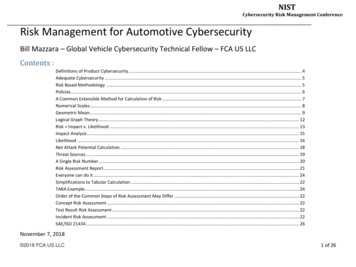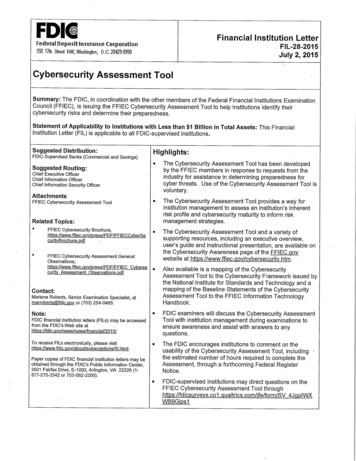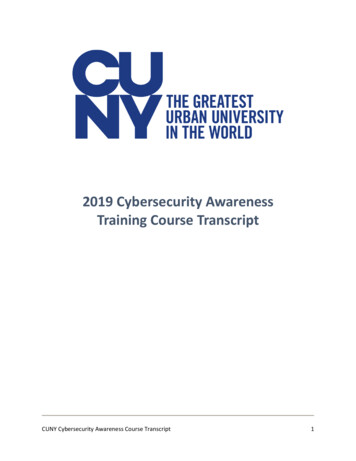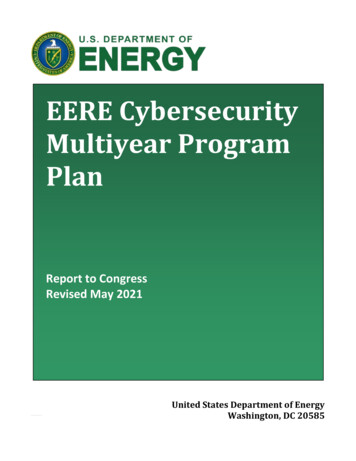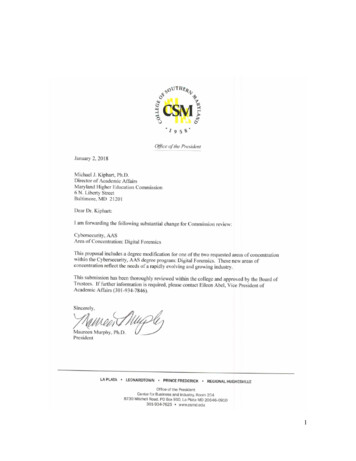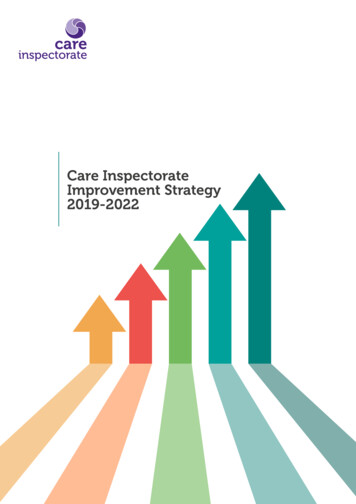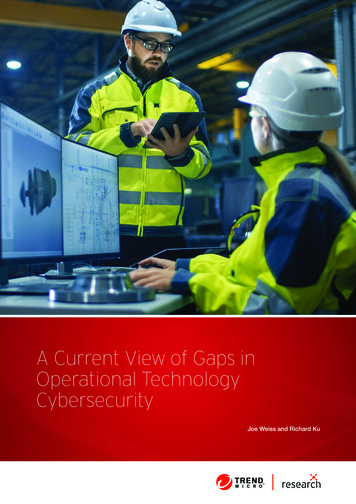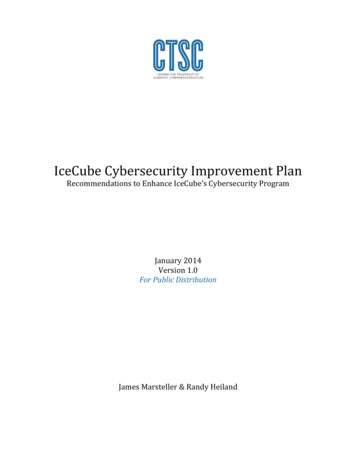
Transcription
IceCube Cybersecurity Improvement PlanRecommendations to Enhance IceCube’s Cybersecurity ProgramJanuary 2014Version 1.0For Public DistributionJames Marsteller & Randy HeilandBlue bar should align at far right with the far right text of the title
About CTSCThe mission of the Center for Trustworthy Scientific Cyberinfrastructure (CTSC, trustedci.org) isto improve the cybersecurity of NSF science and engineering projects, while allowing thoseprojects to focus on their science endeavors. This mission is accomplished through one-on-oneengagements with projects to address their specific challenges; education, outreach, andtraining to raise the state of security practice across the scientific enterprise; and leadership onbringing the best and most relevant cybersecurity research to bear on the NSFcyberinfrastructure research community.AcknowledgmentsCTSC’s engagements are inherently collaborative; the authors wish to thank the IceCube team,especially Steve Barnet, Gonzalo Merino, Paul Wisniewski, and Matt Newcomb, for thecollaborative effort that made this document possible.This document is a product of the Center for Trustworthy Scientific Cyberinfrastructure (CTSC).CTSC is supported by the National Science Foundation under Grant Number OCI-1234408. Formore information about the Center for Trustworthy Scientific Cyberinfrastructure please visit:http://trustedci.org/. Any opinions, findings, and conclusions or recommendations expressed inthis material are those of the author(s) and do not necessarily reflect the views of the NationalScience Foundation.Using & Citing this WorkThis work is made available under the terms of the Creative Commons Attribution 3.0 UnportedLicense. Please visit the following URL for /deed.en USSite this work using the following information:J.A. Marsteller and R.W. Heiland, “IceCube Cybersecurity Improvement Plan,” Center forTrustworthy Scientific Cyberinfrastructure, trustedci.org, January 2014. Available:http://hdl.handle.net/2022/17364This work and updates (if any) are available on the web at the following URL:http://trustedci.org/icecube/IceCube Cybersecurity Improvement Plan v1.02
Table of ContentsStatus . 3Abstract . 31 IceCube Cybersecurity Plan Overview . 4Figure 1. Cybersecurity Program Lifecycle . 52 IceCube Cybersecurity Planning Goals . 62.1 High Risk Mitigation Recommendations . 62.2 Medium Risk Mitigation Recommendations . 62.3 Long Terms Goals / Recommendations. 73 Author Information. 10StatusThe IceCube Cybersecurity plan is in active status. Future revisions will be documented in thissection.AbstractCTSC and IceCube undertook a collaborative effort to conduct a cybersecurity risk assessmentthat analyzed the existing IceCube cybersecurity plan and cyberinfrastructure. The riskassessment was used to gather, document, and prioritize IceCube risks. From that assessmentCTSC and IceCube developed this cybersecurity plan with a set of recommendations for IceCubeto improve their existing cybersecurity program. This cybersecurity plan was developed basedon the identified risks, threats and vulnerabilities from the assessment exercise. The result is aninformed approach to the cybersecurity for the IceCube cyberinfrastructure.For the purpose of this document we are defining a Cybersecurity Plan as a long-termstructured approach to develop, implement and maintain an environment that ensures thereliability and trustworthiness of organizational assets.IceCube Cybersecurity Improvement Plan v1.03
1 IceCube Cybersecurity Plan OverviewCTSC team members and IceCube staff undertook a collaborative effort to conduct acybersecurity risk assessment and to develop a cybersecurity plan for the IceCube. This effortbegan in May 2013 with the formation of the CTSC team and initial communications with SteveBarnet and Gonzalo Merino of IceCube. Over the following months, the CTSC and IceCubeconducted a risk assessment exercise considering both IceCube’s cyberinfrastructure andexisting cybersecurity plan that identified key areas in need of development that wouldstrengthen the security posture of the IceCube environment.In addition to this cybersecurity plan, a separate report documenting the risk assessmentprocess and its findings are included in the final deliverables for this engagement.Cybersecurity planning begins with identifying the assets that are of value to theorganization and implementing a set of controls to minimize the risk to those assets from awide variety of threats. The result of such an assessment can be used to prioritize tasks andallocate the resources providing the most effective risk management strategy.When approaching the task of developing a cybersecurity plan for IceCube, the CTSC teammembers applied the cybersecurity planning lifecycle methodology featured in Figure1. Steps 1 through 3 have been completed during this engagement:1. Defining the project goals and documenting the operational environment. Includingreview of IceCube’s existing Cybersecurity policies, procedures and plan.2. Identifying risks, threats and impact to IceCube assets.3. Identifying controls that can be implemented to minimize the risk to IceCube assets.The next step is to apply the recommendations (controls) to the IceCube environment foundin Section 2, “IceCube Cybersecurity Planning Goals.” The recommendations have beencategorized into a plan based upon a number of considerations including the findings of therisk assessment process, observations made during the engagement and comparison tocommonly used best practices for the CI community.As a result of the work performed in the engagement, it should be acknowledged that theCTSC team found IceCube to have a relatively mature cybersecurity program in comparisonto other CI projects of similar size. For reference, the following existing IceCube policies,procedures and related documents that support the IceCube cybersecurity program werereviewed: 1UW-IceCube Security Policy and ProceduresAcceptable Use Policy and IceCube VO1IceCube Incident Response and Escalation pIceCube Cybersecurity Improvement Plan v1.04
IceCube Network Security Zones (Infrastructure Diagram - “i3zones.pdf”)IceCube Science DMZ (Infrastructure Diagram - “Science DMZ.pdf”)IceCube Live System Security2It seems clear that having to interact with the facility at the South Pole, which operatesunder FISMA, caused IceCube to have to initially consider and document theircyberinfrastructure and cybersecurity. However, as with any cybersecurity plan, IceCube’smust be regularly reviewed and adjusted as the environment and personnel are always in astate of change. New threats emerge and the cybersecurity plan must anticipate these newhazards and offer protection and guidance when they arise. And finally, one must be alert todegradations in the program due to the distractions from the day-to-day operation ofscientific cyberinfrastructure and the loss of knowledge that can come about from personnelchanges.Figure 1. Cybersecurity Program LifecycleProject Goals andEnvironmentDocumentationReviewApply SecurityControls2Identify Risks,Threats,Vulnerabilities AndImpactIdentify Controls ToMitigate ces/Document-55765IceCube Cybersecurity Improvement Plan v1.05
2 IceCube Cybersecurity Planning GoalsThis section lists overall recommendations for risk mitigation that have been categorized into aplan based upon a number of considerations including the findings of the risk assessmentprocess, observations made during the engagement and comparison to commonly used bestpractices for the CI community. IceCube’s past work in developing a cybersecurity program wasconsidered during the assessment process and as a result, it was found to be well positioned inaddressing the most critical threats that were identified. Because of this past work, there wereno high risk threats that were identified.2.1 High Risk Mitigation RecommendationsThere were no ‘High’ risk threats identified through the risk assessment process.2.2 Medium Risk Mitigation RecommendationsThis section sets out recommendations for controls that (a) would have a significant impact onimproving the IceCube cybersecurity posture and/or (b) are deemed important enough thatwork should begin on them as soon as is possible. These recommendations have beensuggested to address the ‘Medium’ threats identified out of the risk assessment process.1. Identify information security responsibilities for IceCube, i.e., the person (or team) thatleads IceCube security. At a minimum this should include operational security, securitypolicies, incident response, and the overall vision for the IceCube securityprogram. Security teams are effective when they have representation from key areaswithin a project such as networking, system administration and management.2. Increase frequency and automate vulnerability scans for all IceCube network connecteddevices. The risk assessment identified medium level risk in vulnerable IceCubeservers. Identifying and addressing vulnerabilities in IceCube’s infrastructure is critical inprotecting against attackers who are continually scanning the Internet for resourcesthey can compromise. IceCube conducts vulnerability scans on a semi-monthly basis.We recommended this activity be increased to weekly scans. The scanning tool IceCubeuses (Nessus) can be scheduled to run automatically without human involvement. Failedscans can be sent to an email list ‘security-alert@icecube.wisc.edu’ (that includesmembers of the security team) for remediation. We also recommend web applicationscanning (e.g., IBM Security Appscan3) of the i3Live web server on a weekly basis aswell. And we recommend the security team sign up to automatically /appscan/IceCube Cybersecurity Improvement Plan v1.06
vulnerability notices4 for the Django web application framework5 and apply upgradesaccordingly.3. Review, update and communicate IceCube operational procedures. IceCube has anumber of existing policies, including the UW-IceCube Security Policy and Proceduresdocument, Acceptable Use Policy and Incident Response procedures. Havingdocumented policies and procedures helps ensure that all users, PIs, and staff membersunderstand their respective roles and responsibilities. The existing policies weredeveloped some time ago by a former IceCube staff member. We recommendreviewing these policies, updating them and communicating them on an annual basis.There were some specific areas that were identified in the risk assessment that couldbenefit from continued development. For example, some additions to the acceptableuse policy covering credential management (using strong passwords, managing andprotecting) would help promote awareness of IceCube’s policies. The University ofWisconsin-Madison Office of Campus Information Security publishes a “Creating aStrong” password guide6 that could be referenced.2.3 Long Terms Goals / RecommendationsThe set of controls in this category are deemed important, but are recognized as being involvedand needing additional time to develop. Like the controls found in previous areas in this report,several will need a more formal process put in place to address the issues on a continualbasis. These long term recommendations should be considered and planned as soon aspossible.The long term recommendations have been broken into the following two, broadcategories: Operational Recommendations and Auditing and Review ProcessRecommendations.Operational Recommendations1. Develop a cybersecurity awareness program. A security awareness program is anorganized approach to inform staff about IceCube’s security related policies andprocedures as well as general security related tips (identifying social engineeringattacks, keeping desktops/laptops secure, etc.). The awareness program can use avariety of ways to communicate to users: email notifications, annual training ity-list/vendor id-10199/product id-18211/Djangoproject-Django.html6 aspx5IceCube Cybersecurity Improvement Plan v1.07
on-line resources, etc. Ideally some form of cybersecurity awareness should beincorporated into new employee training program.2. Implement an intrusion detection system. An intrusion detection system (IDS) monitorsnetwork and system activities for malicious activities or policy violation. These systemscan take the form of software or devices. There are a number of different optionsavailable but one crucial component is the development of the skills needed tounderstand the results of the IDS. IDS systems can be broken into two categories:network and host based systems.Host based IDS systems monitor the host, or computer, they reside on. These systemslook at both the dynamic behavior and the state of the computer. For example, thesystem would monitor the operating and file systems of the host. A profile would bedeveloped on each file, including such things as size, permissions, modification dates,etc. This information would be watched and tracked. If system files are suspiciouslymodified or there is other unexpected activity, the IDS could notify administrators forfurther investigation.Network based IDSs detect intrusions by analyzing network traffic and looking for signsof attack. These systems take two forms: Rule based systems look at network traffic and system activities for patterns thatmatch known exploits. These known events are the rules that the systemmatches against. This is much like how antivirus software works.Analysis based systems monitor network and system activities for events that falloutside the normal usage. This could include such events as abnormalbandwidth, protocols, ports, foreign IP addresses or devices generally not used,etc.There are a number of (mostly) open source IDS projects that we recommend:All InclusiveSecurity-onion (http://securityonion.blogspot.com/)Host BasedOSSEC (http://www.ossec.net/)Samhain (http://la-samhna.de/samhain/)Tripwire (http://www.tripwire.com - Commercial product)Network Based Snort (http://snort.org/)Suricata (http://suricata-ids.org/)Bro (http://bro-ids.org/)IceCube Cybersecurity Improvement Plan v1.08
3. Expand the IceCube Incident Response Plan. When IceCube experiences a securityevent, some type of incident response is necessary. A good incident response plan canminimize the effects of a security breach, allowing for a quick recovery and avoidingnegative publicity. IceCube has had an established Incident Response and Escalationplan for a number of years. Some consideration should be given to expand the existingpolicy to give direction on documenting events and learning from them. This will helpwith measuring the effectiveness of response process and can be used to makeadjustments for improvement. It can also act as a learning tool to avoid repeating pastmistakes and for new staff that were not involved in the initial response.In addition to expanding event documentation, information sharing guidelines should beconsidered. How are security events communicated to users, project management,funding agencies and other stakeholders? Answers to these questions should bedecided upon well in advance of an incident.The following resources provide Incident Response plans that can be used forcomparison. Tulane University Computer Incident Response Plan7RedHat Incident Response Guide8NIST Incident Response Guide94. Track Science DMZ Best Practices. IceCube (at least at UW-Madison) operates a ScienceDMZ, which is a relatively new concept at this point. We recommend that IceCubecontinues to track emerging best cybersecurity practices coming from ESnet and thebroader community. One recommendation would be to assign at least one member ofthe IceCube team to subscribe to the ScienceDMZ mailing list10 in order to learn fromand contribute to that community. Additionally, checking network performance andreliability using the recommended tool, perfSONAR11, on a continual basis would be agood practice. Regarding the (secure) movement of large amounts of data over a DMZ,IceCube may want to investigate the use of Globus Online12 as a cloud-based service forits user community.7http://isowiki.tulane.edu/Tulane Information Security Policies/Tulane University Computer Incident ocs/en-US/Red Hat Enterprise Linux/3/html/Security Cube Cybersecurity Improvement Plan v1.09
Auditing & Review Process Recommendations5. Plan Audit & Review. All of the above proposed recommendations will only be effectiveif they are closely watched and modified as time progresses. This means there is a needfor auditing of the controls themselves so that weaknesses in the approach can beidentified and addressed. Along with the auditing, regular reviews are necessary todetermine the effectiveness of the control.Without regular reviews, a cybersecurity strategy will quickly become out of date and itseffectiveness will diminish. At a minimum, an annual review of the cybersecurity plan,beginning with a risk assessment activity, should be conducted to determine whatchanges have taken place that the plan doesn’t address.The review may identify the need for new policies, procedures, training/education andsecurity controls that should be added to a revised cybersecurity plan.3 Author InformationThis document is a product of the Center for Trustworthy Scientific Cyberinfrastructure (CTSC trustedci.org). CTSC is supported by the National Science Foundation under Grant Number OCI1234408. For more information about the Center for Trustworthy Scientific Cyberinfrastructureplease visit: http://trustedci.org/. Any opinions, findings, and conclusions or recommendationsexpressed in this material are those of the author(s) and do not necessarily reflect the views ofthe National Science Foundation.James Marsteller jam@psc.eduCarnegie Mellon UniversityPittsburgh Supercomputing Center300 South Craig StreetPittsburgh, PA 15213Tel. 412-268-5184Randy Heiland heiland@iu.eduCenter for Applied Cybersecurity ResearchIndiana University2719 E. 10th Street, Suite 201Bloomington, IN 47408Tel. 812-552-6127IceCube Cybersecurity Improvement Plan v1.010
commonly used best practices for the CI community. As a result of the work performed in the engagement, it should be acknowledged that the CTSC team found IceCube to have a relatively mature cybersecurity program in comparison to other CI projects of similar size. For reference, the following existing IceCube policies,


